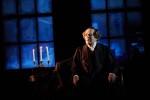An ornate coffin that stands open upon a stage is the impressive opening image of “Charles Dickens’ A Christmas Carol.” An eerie haze dances under sapphire lighting, signaling the wintry tale that will ensue.
Shortly after, an unnamed narrator lights a candle and begins telling the tale of Ebenezer Scrooge to audience members unnerved by the sudden darkness. It quickly becomes clear that the narrator is, in fact, Scrooge himself, as well as all the other characters featured in Los Angeles’ most recent one-man adaptation of Dickens’ classic novel.
Running through Dec. 9 at the Geffen Playhouse, “A Christmas Carol” stars Jefferson Mays as the omniscient narrator, Scrooge, the three ghosts and numerous others as he recounts the story of a man who hated Christmas. Haunted by his past, present and future, Scrooge realizes he must make amends if he hopes to live a wholesome life. Mays’ performance is certainly commendable, but the true magnificence of the play is in its production design, and its ability to spark a keen sense of fear in select scenes.
As Mays lights the stage with candles, the audience sees the office of Scrooge and his late business partner Marley. He spins while holding the candle stand, and a board reading “Scrooge & Marley” briefly lights up and vanishes again. Furnished with wooden doors and shuttered windows, the office is a cold and dreary setting, quite akin to Scrooge’s spirit. Mays makes complete use of the space: When he opens window shutters, light floods onto the stage, accompanied by ambient sounds like those of howling winds and trotting horse carriages – cliche as it may sound, it is almost as if the audience is there with him.
The set and lighting design show new levels of proficiency when the ghosts arrive. Marley’s spirit first comes to Scrooge in the middle of the night, warning him about the three hauntings to follow. When he flails his arms as Marley’s ghost, the clanking of metal echoes through the theater, and the suspension of disbelief doesn’t take much effort.
There is beauty in the show’s simplicity. There are some elaborate moving set pieces, but the general lack of props and an ensemble cast adds to the charm by highlighting Mays’ performance. Admittedly, the initial realization that one man will play distinctly different characters is jarring. But Mays’ prowess quickly ensures that this lingering tension dissipates. He convincingly switches between Scrooge’s grumpy exclamations of “Humbug!” and Marley’s troubled ghost with motionless eyes and twisted fingers in mere seconds, with nothing more than lighting and sounds to signal the transitions.
When Scrooge encounters the first ghost – a spirit that invokes bittersweet nostalgia through the memories it recreates – the stage becomes illuminated with silvery light and smoke that swirls in enchanting patterns. The atmosphere, for the first time, becomes playful and light for a brief period. As the spirit finishes showing him snippets of his past, Scrooge falls to his knees and begs for forgiveness. His character arc occurs perhaps too quickly. The emotional impact may have lasted longer if his change from frosty to soft was more gradual. But Mays finds his redemption soon after, when the Ghost of Christmas Present arrives.
In past renditions, it is usually one of the other two ghosts that elicits the most emotion, but in the Geffen’s story, this middle segment was somehow most effective. The Christmas present is resplendent with touching moments, with humor delicately balanced with raw emotion in the family setting. Mays enacts multiple members of a lower-class family, the father of which works for Scrooge. The family is struggling, and their youngest son Tiny Tim suffers from a terminal disease, but together, on Christmas, they are happy. And yet Scrooge, who lives in the luxury of his manor with enough money to go around, cannot relate. The scene is poignant, and touches upon universal themes of financial health, the holiday spirit and togetherness, making the Christmas present perhaps the most compelling part of the show.
As the show progresses into the future, toward Scrooge’s most desperate moments, Mays narrates less and embodies the character more. The final ghost appears as a dark shadow, true to canon, and takes Scrooge through dark city streets, into a graveyard, and to his own bedroom, where he sees a corpse rotting under a pale sheet. Each of these images are hard-hitting, and are made more gutting by Mays quaking knees and cracking voice.
The play, up until this point, has done a striking job of creating fear throughout appropriate scenes. Although it is distinctly more difficult to feature horror in live shows, “A Christmas Carol’s” jump scares and work with lighting and shadows ensure that by the time the spirit arrives, the audience is already on edge, expecting to be startled at any given moment – that in itself, is probably one of the play’s greatest victories.
“A Christmas Carol” is worth the watch merely for its production value – that much is clear. But clubbed with Mays’ brilliantly ubiquitous presence, the show becomes an apt catalyst to thaw frigid souls just in time for the holidays.
